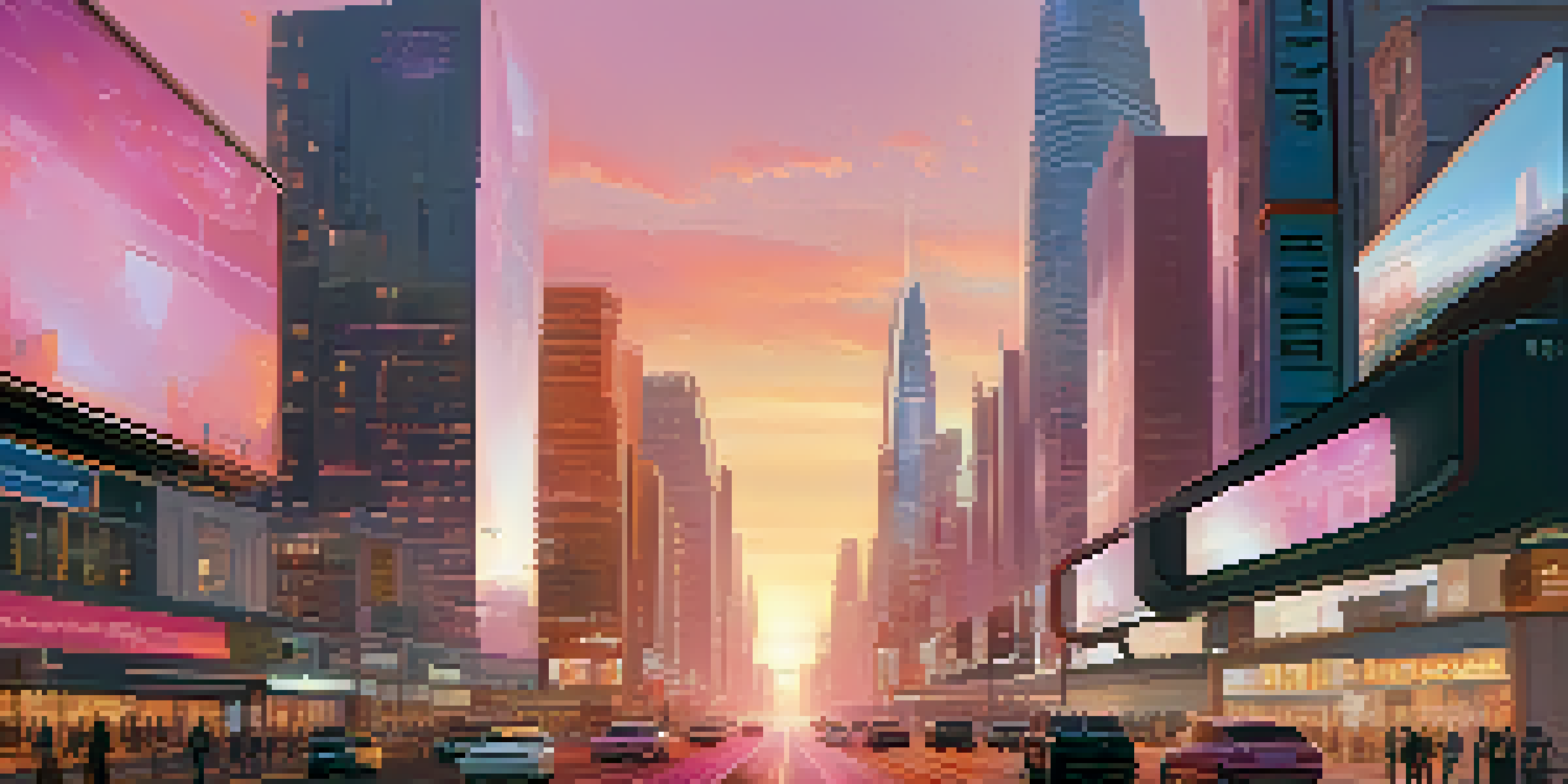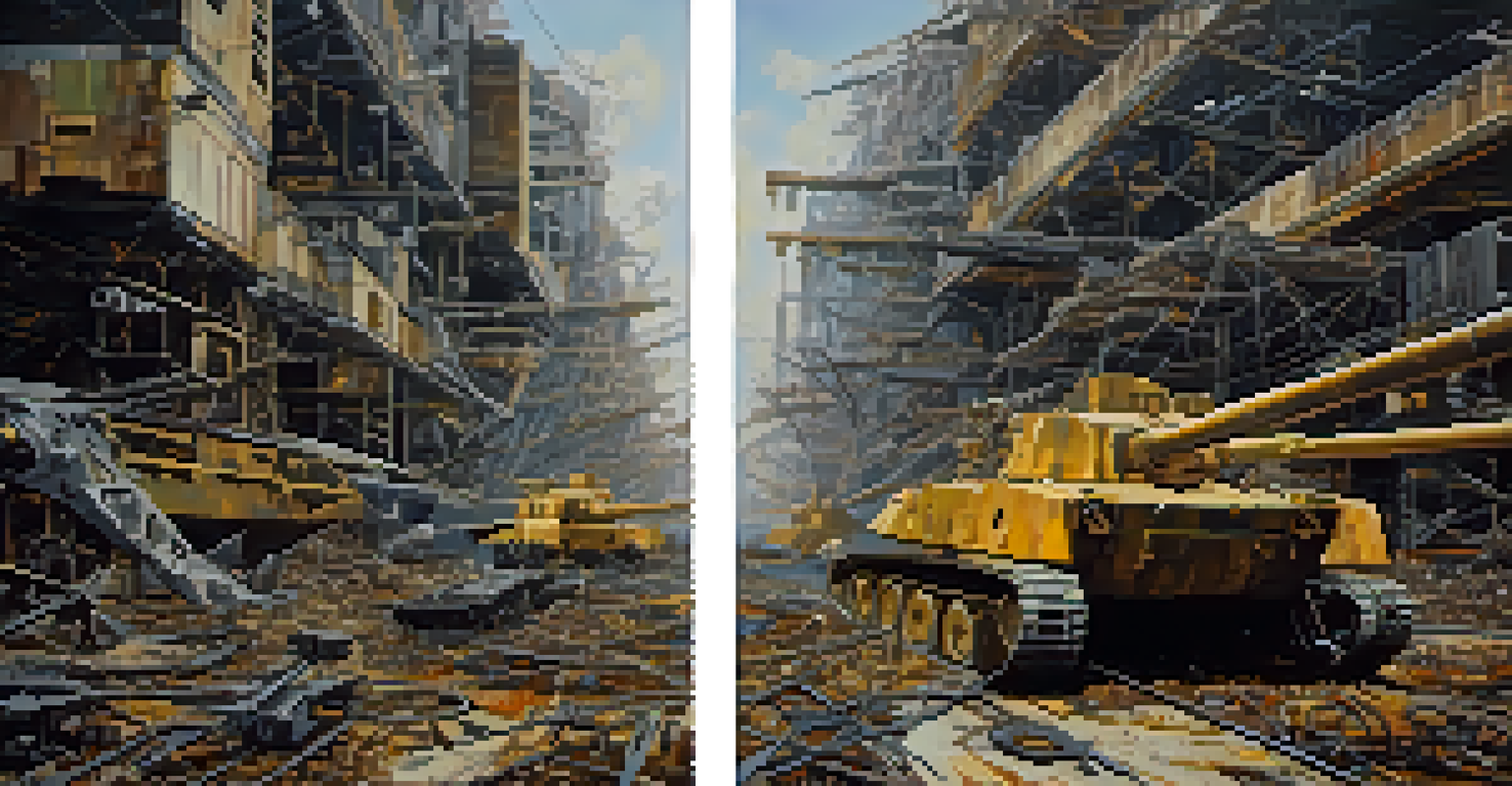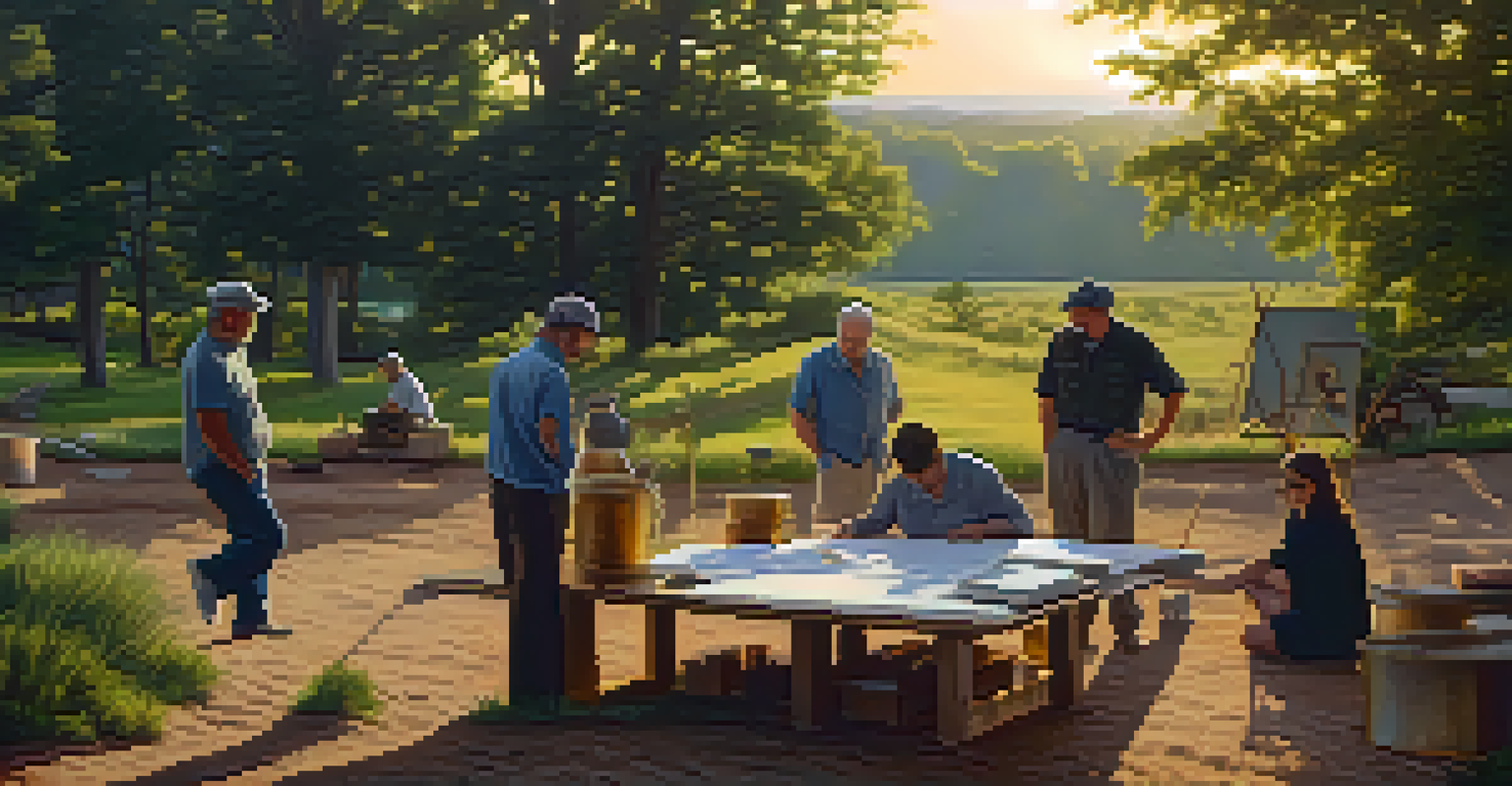Impact of War on Futurism: Art as a Reaction

Understanding Futurism: A Movement Born from Change
Futurism emerged in the early 20th century as a response to rapid industrialization and societal shifts. Artists of this movement sought to capture the dynamism of modern life, emphasizing speed, technology, and movement. The thrill of the machine age inspired these creators to envision a new world, one that was vibrant and forward-looking. However, this same energy was often juxtaposed with the harsh realities of war, leading to a complex relationship between art and conflict.
Art is not a mirror held up to reality, but a hammer with which to shape it.
As World War I broke out, futurism was both challenged and invigorated by the chaos surrounding it. The initial enthusiasm for war as a cleansing force began to wane, leading artists to grapple with the destruction and loss that accompanied it. This shift in perspective prompted many futurists to reconsider their ideals, exploring themes of violence and disillusionment in their work. The war became a catalyst for a deeper exploration of the human experience, inviting artists to reflect on the costs of progress.
Ultimately, futurism's evolution during wartime highlights the adaptability of art as a medium for expressing societal struggles. While the movement initially celebrated the future, it transformed into a platform for critiquing the very forces that sought to shape it. This duality is crucial in understanding how war can both inspire and distort artistic vision, leading creators to forge new paths amidst adversity.
Art as a Reflection of War’s Brutality and Impact
War's brutality often serves as a stark backdrop for artistic expression. Artists have long used their work to document the horrors of conflict, capturing the visceral emotions and experiences of those affected. Through various mediums—painting, sculpture, and literature—these creators provide a window into the suffering and resilience of humanity during tumultuous times. This reflection allows audiences to confront the often-unseen realities of war, fostering empathy and understanding.

For example, the works of artists like Otto Dix and Georges Braque during and after World War I poignantly illustrate the devastating impact of war on the human psyche. Dix's raw depictions of wounded soldiers and Braque's fragmented forms evoke the disorientation and trauma experienced by individuals in the aftermath of conflict. Such portrayals not only document historical events but also challenge viewers to reckon with the emotional fallout of violence. Through these artistic responses, the personal becomes universal, bridging the gap between individual experiences and collective memory.
Futurism's Shift from War to Peace
As perceptions of war evolved, futurism transformed from celebrating conflict to exploring themes of compassion and understanding.
This process of reflection can also lead to catharsis, both for artists and their audiences. By confronting the darkness of war through art, creators can process their trauma and provoke dialogue around healing and recovery. The resulting works can inspire a sense of hope or a call to action, urging society to prevent the recurrence of such violence. In this way, art becomes a powerful tool for navigating the complexities of human experience in the face of war.
Futurism’s Response to Changing Perceptions of War
As perceptions of war shifted throughout the 20th century, so did the narratives within futurist art. Initially viewed as a means of purification and rebirth, war began to be seen as a catalyst for destruction and despair. This change prompted artists to explore the darker aspects of human nature and the consequences of unchecked ambition. The transformation of futurism reflects a broader societal reevaluation of the glorification of war and its implications.
The role of the artist is to make the revolution irresistible.
In the 1920s and 1930s, many futurists began to distance themselves from the violent ideals that had once inspired them. Artists like F. T. Marinetti, who initially celebrated war, started to question its merits as the aftermath of conflict became clearer. This introspection marked a significant turning point, as futurism transitioned from a celebration of the future to a more nuanced understanding of progress, one that acknowledges the scars left by conflict. It highlights the importance of critical engagement with the ideals that once fueled the movement.
Consequently, futurism evolved into a platform for exploring themes of peace, reconciliation, and the potential for rebuilding. This shift in focus allowed artists to envision a future that is not solely defined by technological advancement, but also by compassion and understanding. By embracing this complexity, futurism continued to influence generations of artists, urging them to consider the broader implications of their work in relation to war.
The Role of Technology in War-Inspired Futurism
Technology plays a pivotal role in both war and the futurist movement, intertwining their narratives in profound ways. While futurism initially celebrated technological advancements as symbols of human progress, the realities of war exposed the darker side of innovation. The rise of mechanized warfare and the destruction it wreaked prompted artists to reassess their relationship with technology. This complex interplay invites discussions about the moral implications of progress and the role it plays in shaping our future.
For many futurists, technology became a double-edged sword. On one hand, it represented the potential for advancement and new horizons; on the other, it served as a tool for devastation. Artists like Umberto Boccioni captured this duality in their works, emphasizing the interplay between human emotion and technological progress. As they grappled with the consequences of warfare, futurists began to explore how technology could be harnessed for creative rather than destructive ends, envisioning a future where innovation serves humanity as a whole.
Art Reflects War's Brutality
Artists utilize various mediums to document the emotional and physical toll of conflict, fostering empathy and dialogue.
This ongoing dialogue between technology and art continues to resonate today, as modern creators reflect on the impact of contemporary advancements. From virtual reality to artificial intelligence, artists today grapple with similar questions about the role of technology in shaping society. By examining the historical context of futurism, we can better understand the complex relationship between innovation and conflict, and how art can serve as a lens through which to explore these themes.
Post-War Futurism: Reimagining a New World
The aftermath of war often leads artists to reimagine the world around them, a theme strongly reflected in post-war futurism. With the scars of conflict still fresh, artists sought to envision a future that embraced healing and renewal. This shift in focus allowed for a redefinition of what progress means, emphasizing collaboration and understanding over competition and destruction. As they navigated this new landscape, artists played a crucial role in shaping collective hopes for a better tomorrow.
In the wake of World War II, futurism experienced a resurgence as artists began to explore themes of utopia and possibility. This era marked a departure from the pessimism of earlier war-inspired art, as creators turned their attention to the potential for reconstruction and innovation. Artists like Lucio Fontana and Enrico Baj embraced a spirit of optimism, envisioning a future where art and technology could work hand in hand to foster social change. Their works reflect a belief in the transformative power of creativity in the face of adversity.
Post-war futurism serves as a testament to the resilience of the human spirit, illustrating how art can offer hope and inspiration even in the darkest of times. By imagining a new world shaped by compassion and collaboration, artists challenge society to move beyond the cycle of conflict. This hopeful vision continues to resonate today, reminding us of the enduring power of art to inspire change and foster a sense of shared humanity.
The Intersection of War and Cultural Identity in Art
War often shapes cultural identities, and artists have a unique ability to capture this intersection through their work. The experiences of conflict can redefine societal values, beliefs, and traditions, all of which influence artistic expression. As artists navigate their cultural landscapes, they draw from their heritage, infusing their work with personal and communal narratives. This rich tapestry of identities serves as a powerful reminder of the diverse experiences shaped by war.
For instance, artists from war-torn regions frequently reflect their struggles and resilience in their creations. The works of artists like Shirin Neshat and Ai Weiwei illustrate how personal experiences of conflict can transcend borders, resonating with audiences worldwide. Their art speaks not only to their own histories but also to universal themes of displacement, identity, and the quest for belonging. In this way, artists become storytellers, weaving together the threads of their cultural identities with the complexities of war.
Technology's Dual Role in Art
While futurism initially embraced technological advancements, the realities of war prompted artists to reassess how technology shapes human experience.
By exploring the intersection of war and cultural identity, we gain insight into the broader implications of conflict on artistic expression. Art becomes a means of preserving memory, fostering dialogue, and promoting understanding across cultural divides. In a world where divisions often overshadow shared humanity, these artistic narratives remind us of our interconnectedness and the power of creativity to bridge gaps and heal wounds.
The Continuing Influence of War on Contemporary Futurism
As we enter an era marked by rapid change and uncertainty, the influence of war on contemporary futurism remains palpable. Today's artists continue to grapple with the legacies of past conflicts while responding to new challenges such as climate change, social inequality, and geopolitical tensions. This evolving landscape invites creators to explore the implications of these issues through their art, pushing the boundaries of futurism beyond its historical roots. The merging of traditional futurist themes with contemporary concerns results in a dynamic dialogue that remains relevant in today's society.
Contemporary artists are increasingly using technology and new media to engage with the realities of conflict and its aftermath. Interactive installations and digital art provide platforms for storytelling, allowing audiences to immerse themselves in the narratives of those affected by war. By leveraging innovation, artists can create experiences that provoke thought and inspire action, ultimately contributing to a more informed and empathetic society. This approach underscores the importance of adaptability in art, as creators respond to the shifting landscapes of our world.

The ongoing exploration of war's impact on futurism highlights the resilience of art as a response to human experience. As artists continue to navigate complex themes of conflict, identity, and technology, they challenge us to envision a future that is not only shaped by progress but also by compassion and understanding. By engaging with these narratives, we can foster a deeper appreciation for the role of art in shaping our collective future.